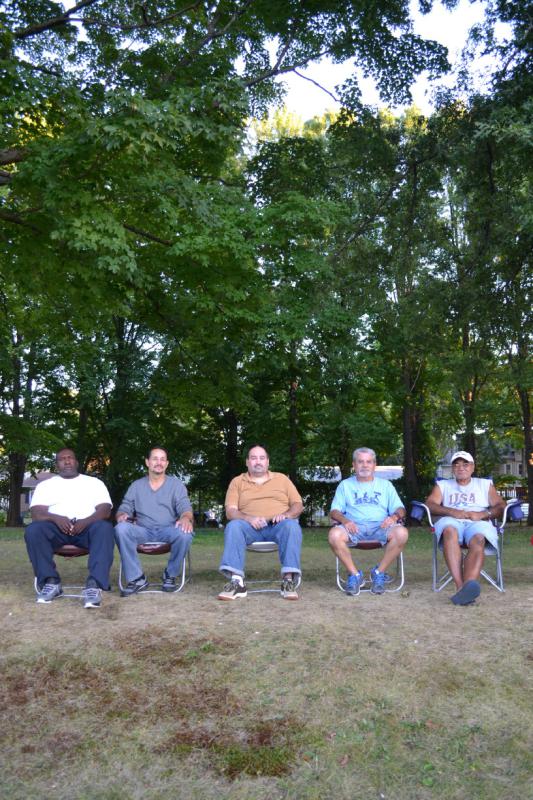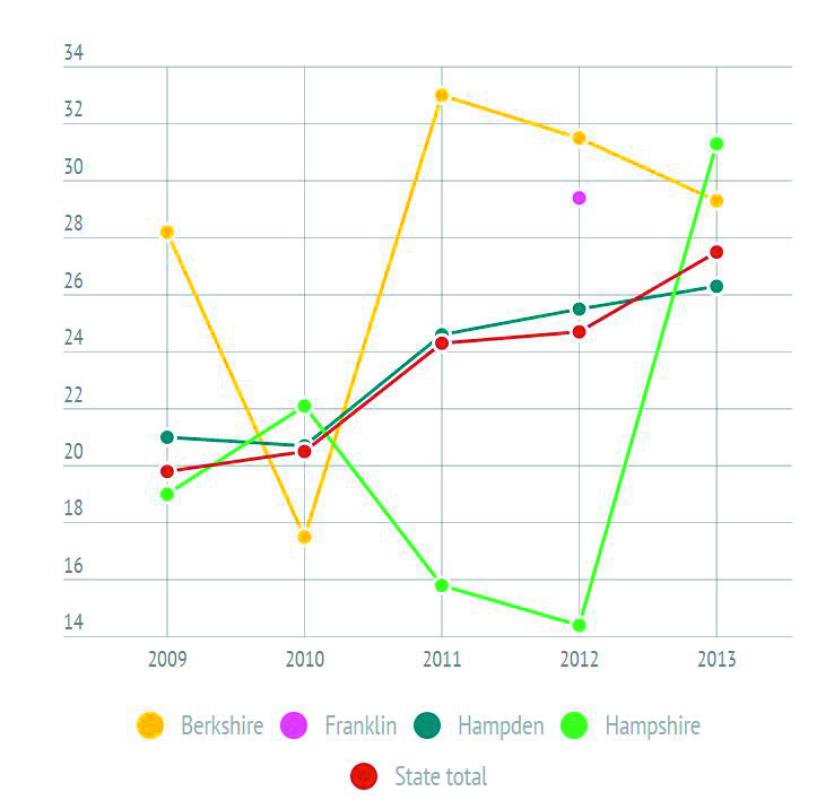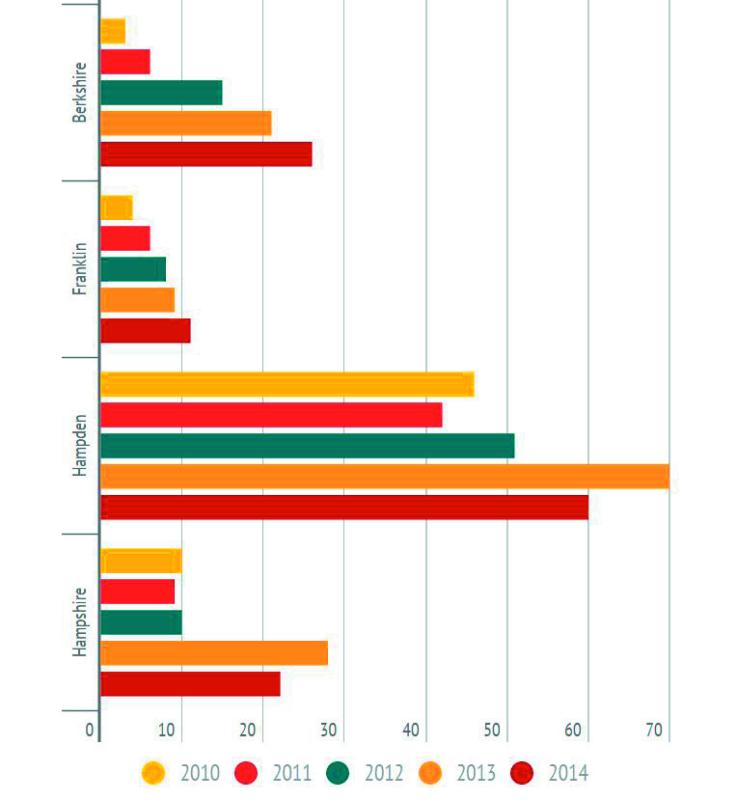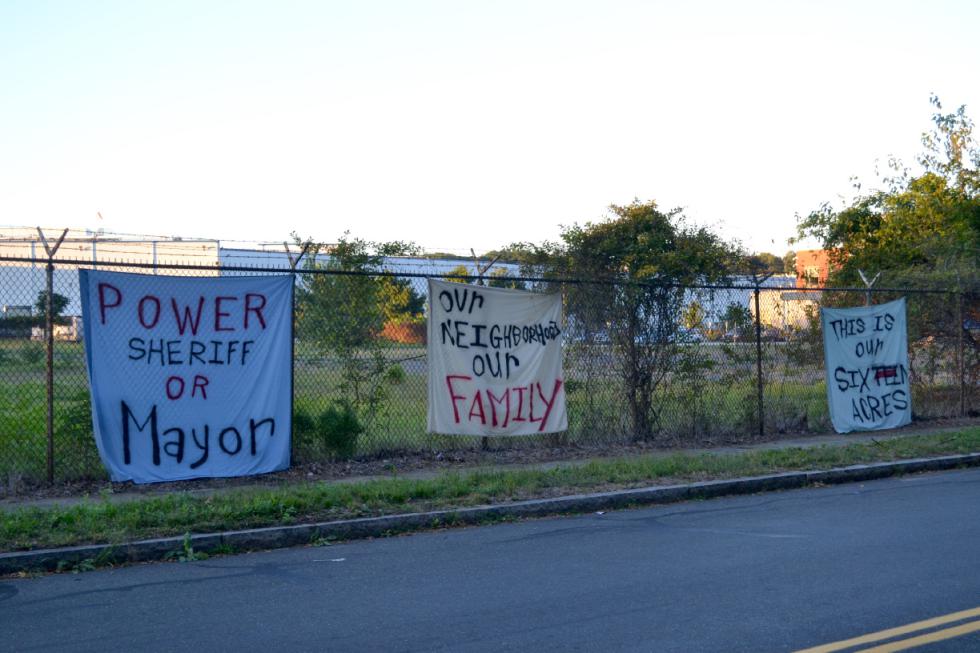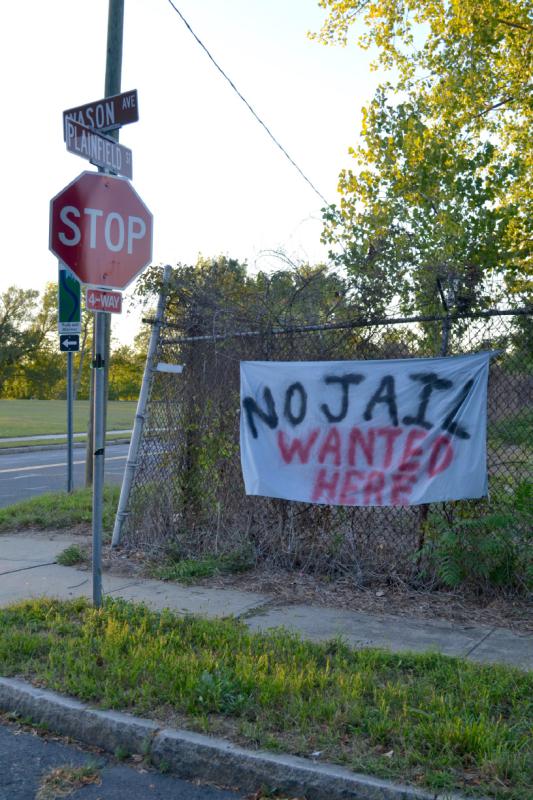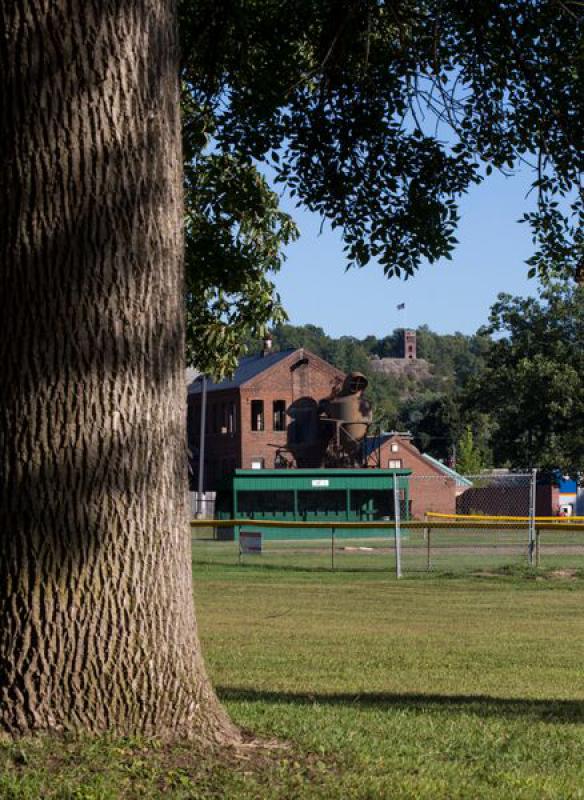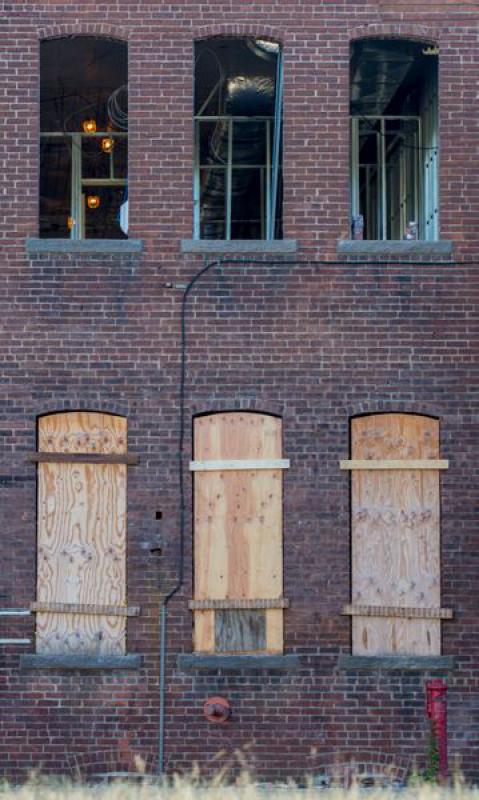Mariette Poginy sighs, pivots in her porch chair, and looks across Norwood Street in Greenfield, where the banging of hammers and the whining of drills emanate from the former Lunt Silversmiths factory. If all goes according to plan, the vacant and overgrown building will become a drug detox and rehab center by the end of the calendar year.
“I know we need something like this,” she says, shaking her head. “But to put it right in town — I think it’s a mistake.”
Poginy bought her house in 1990, when she moved from Brattleboro to Greenfield to work as a hairdresser at Wilson’s Department Store on Main Street — a job she still holds. Over the decades, she says, she has seen firsthand how the epidemic of opioid addiction has struck Franklin County.
Still, she is unhappy with the idea of a rehab center — run by the Springfield-based nonprofit Behavioral Health Network — right next to her house. She says that she is concerned for her safety among the addicts who will soon be coming to this block for treatment, and that she is considering moving.
“I just think this is the wrong place for it,” she says. “It’s certainly not beneficial to any of the neighbors.”
Hold up. While the inclusion of a rehab center in a neighborhood could drive down home values due to the stigma surrounding addiction, to say that the center won’t help any neighbors is a stretch. Even if you have not encountered an addict living on your street, the chances that you already know at least one in your social circles — or your family — are higher than ever. As of this year, 23 million Americans — that’s more than three times the population of Massachusetts — live with some form of substance dependence or abuse, according to the annual National Survey on Drug Use and Health. And the Massachusetts Department of Public Health has reported that from 2000 to 2012, the number of unintentional fatal opioid overdoses in the state increased by 90 percent.
In response, Gov. Deval Patrick declared a state of emergency in March 2014. Two months later, the public health officials recommended that a detoxification program be created in Franklin County — a region that has had no such program since Franklin Medical Center closed its Beacon Recovery Center detox facility in 2003 due to budget cuts under Gov. Mitt Romney.
Few would deny that the Valley needs addiction treatment centers to fight the drug epidemic. The question is, where should they go?
Even as Greenfield neighbors are grappling with the prospect of a new center, a group of residents in Springfield’s North End are pursuing legal action to halt the construction of an addiction treatment center on Wason Avenue. On Sept. 10, lawyer Shawn P. Allyn filed an emergency motion in Hampden Superior Court to temporarily stop work on the development of a new Western Massachusetts Correctional Alcohol Center.
The center, which is run by Hampden County Sheriff Michael Ashe, provides educational programs and treatment for imprisoned alcoholics and addicts. After 30 years in Springfield’s South End, the facility had to relocate this spring to make way for the new MGM Springfield casino complex, and their current home in Holyoke is only temporary.
These two dramas are unique, but both strike a common emotional chord: to keep a neighborhood safe, we need to protect “people like us” from “people like them.”
Those fears can be addressed with a short drive up I-91 to Vermont. At the Brattleboro Retreat, the Starting Now outpatient addiction services program has run for more than 20 years in good standing with downtown residents who live and work a few blocks away.
A ccording to Brattleboro Police Chief Michael Fitzgerald, the town has a good relationship with the Retreat, where the programs include walk-in addiction treatment and rehab.
Do rehab centers draw the more criminally-inclined to areas that are otherwise safe?
“What, like the Pied Piper?” says Fitzgerald. “No, I haven’t found that to be the case.”
Some who attend those daily or nightly drop-in sessions walk down Main Street, he says. “And some of them sit at an outdoor table or on a bench and spend the day there. That irritates some of the merchants. So yes, they are visible downtown.”
But many of the people taking advantage of the Retreat’s addiction programs already live in Brattleboro, he adds. “This idea that if you build it, all of a sudden you’ll have criminals and addicts around — I disagree with that mentality. The opposite is true — get the people who are here the help they need, and the crime should taper off. Why turn your backs on them?”
Kurt White is a licensed social worker, drug counselor, and the manager of Starting Now, the outpatient addiction services program at the Retreat. He confirms that a large number of addicts seeking help live in town.
“When you look at crimes committed in the service of a person’s addiction,” he said, “generally those people aren’t coming to get help. They are in the active throes of their addiction. The people coming to get help and rehab are a different cohort. They arrive intentionally, to actively pursue their own recovery.”
White finds the idea that treatment centers attract dangerous outsiders to be “a great misconception about the field.” The way to overcome that, he says, is for treatment centers to actively engage in complicated conversations with local police, residents, and business owners.
“It’s not that there is no tension,” he says. “You just have to put a system in place where the tensions that arise become solvable problems.”
If White were to offer Behavioral Health Network one bit of advice, that would be it. “Outreach in a really sincere, ongoing way. Not just once, but as an ongoing dialogue, in the middle of the community.”
Because in Greenfield, like elsewhere, the opioid epidemic has reached everyone’s front step. Dan Kimball, of Kenwood Street, remembers a day this past spring when neighborhood volunteers picked up needles while cleaning the ballfield outside his house.
“They were finding them in the dugout,” he says. “So, yeah, the problem is already here.”
O n July 16, Greenfield’s planning board held a public hearing to talk residents through the plan for the Lunt factory. Mayor William Martin was in attendance. So was Behavioral Health Network CEO Kathy Wilson, whose organization submitted the only entry in the town’s bid for proposals for the factory.
Behavioral Health Network proposed a center with 64 beds that provides 24-hour inpatient detoxification services on a volunteer basis, as well as programs for assessment, counseling, and aftercare. The Department of Public Health awarded the organization the necessary contracts back in November 2014.
But eight months later, concerns from homeowners were still fresh, and some questions about changes along Norwood and Kenwood Streets went unanswered.
Dan Kimball got up and spoke at the July 16 meeting. Kimball has owned a house on Kenwood Street for 10 years. He is concerned about the lack of specifics provided by the company on matters like the selection and intake of patients, security staffing, and the prevention of loitering and drug dealing outside the building.
Kimball’s house looks out onto Lunt Field, a tree-lined space owned by the town that contains three baseball diamonds. Everyone who grows up in Greenfield, he says, has some connection to that field, including the dozen young children he recently saw playing tag there after dark. “That’s exactly what we want. It’s always been a calm neighborhood.”
He has grudgingly accepted that the project is underway and that the center will open. But if Behavioral Health Network had communicated a more solid game plan for safety and security in the building and on the grounds, he’d “probably feel better about it.”
So would Brian and Beverly Bird, who live a few doors down. They’re both retired, Beverly says, and like everyone else they’ve spoken with on this street, they oppose the rehab center.
“I don’t know the restrictions on these people,” Brian says, referring to the patients. “There’s no breakdown I’ve seen of how controlled people are going to be. I want to know more about the security there, but I’ve seen nothing on that.”
Over on Norwood Street, homeowner Shannon Eaton has a four-month-old daughter. She and her husband have lived here for four years, and she seems almost apologetic about her opposition to the center.
“I go back and forth,” she explains. “I know that the people who will come here need help. But you just don’t know what kinds of people are walking into your neighborhood.”
Kathy Wilson, the company’s CEO, has a simple response to that. She hopes anyone and everyone who needs help shows up, regardless of where they’re coming from.
“It’s hard for someone to get to the point where they can say that they need help,” she says. “At that point, they need really quick, easy access to a bed.”
That’s partly why the Lunt building is a good fit, she says: it is centrally located in a mixed-use residential and commercial area, complete with good parking and bus routes.
Wilson has spent 32 years at the company, which was founded in 1938. She says this new center will follow the model of the Carlson Recovery Center and the Hope Center in Springfield, also run by BHN.
In her experience, patients come to the Springfield centers from far and wide. But she recalls an early walk-through of the Lunt factory, during which she saw several people hiding in unused corners of the abandoned building.
“Vagrancy and drug use are already a part of that neighborhood,” she says. “Having that building fixed up and operating 24 hours a day will give more security, not less.”
When asked whether she thinks the company has explained this well enough to neighborhood residents, Wilson concedes that much is still in the planning stages. Renderings from the contractor are not yet publicly available. They will need to hire a security company and establish a relationship with the Greenfield police department.
Negative reactions from residents at the July hearing did not surprise her at all, she says, but she is confident that people will find the environment to be safe once the building opens. “The fact that we’re building a close-to-home treatment program is something people need to embrace in order for the problem to go away.”
M eanwhile, residents of Springfield’s North End are digging in their heels. At the proposed site for the sheriff’s new Correctional Alcohol Center on Wason Avenue, bedsheets hang from the chain link fence. Bold black and red letters cover the sheets, bearing messages like: “No Jail Wanted Here” and “Our Neighborhood Our Family.”
Across the street from the fencing, five men sit on a small grassy hill in lawn chairs, chatting and smiling at the occasional pedestrian. They have been out here every day this week, explains retired Springfield police officer Ernest Harris, sitting here on rotation within a pool of 30 or 40 interested citizens. Their mission is to be an ever-present representation of the neighborhood’s opposition to the old Howard Street jail moving into the area — and to speak with anyone about why the jail, and its unique drug and alcohol treatment program, should be relocated elsewhere.
For now it is uncertain, given the pending lawsuit filed against the Hampden County Sheriff’s Department, when and if the project will continue, says Harris. The lawsuit was filed by a group of residents alleging the sheriff’s department cannot put a jail in the area because the city’s zoning ordinances will not allow it. “But it could start back up again any time. That’s why we’re here, keeping an eye out.”
Harris says he and his fellow protesters generally support the sheriff’s program — “It’s great, and it does great things for the community” — but they fear a dip in their property values. They also feel their community already has enough going on, with two methadone clinics nearby and the Women’s Correctional Center in Chicopee a stone’s throw away.
“No one’s in opposition to anybody in recovery,” he says. “But at this point, we’re just looking to not be overwhelmed here, just being a dumping ground for facilities all in one place.”
Retired PVTA bus driver Tony, who offered only his first name, says the North End is “nice and quiet all the time, every day. We don’t have any problems — everybody looks out for each other. It’s a beautiful corner of the city right here. We want to keep it like this.”
It’s a classic call to action — keep our streets safe from outsiders — but sheriff’s department spokesman Richard McCarthy is trying to reframe the story.
“A neighborhood is better off having a space where recovering addicts are supervised and supported and helped than they are having an untreated addict climbing through their window,” McCarthy said. “They’re not the same thing.”
McCarthy says that 63 percent of Hampden County inmates are from Springfield, and the Correctional Alcohol Center’s population — which fluctuates between roughly 125 and 150 people — includes people from the North End.
The sheriff’s department has been sending staff members door-to-door in the North End in recent weeks to explain the center’s purpose to residents. They have also held three community meetings. “Those are good, because it gives people an opportunity to vent,” McCarthy says, “but our arguments don’t seem to register.”
Mainly: that the center is a vital public service, and that, as a pre-release program, it needs to be located in close proximity to where these residents are going to re-enter the community.
“We get portrayed as Goliath coming onto David,” he says, “but the real Goliath is the addiction epidemic.”•
Contact Hunter Styles at hstyles@valleyadvocate.com.

